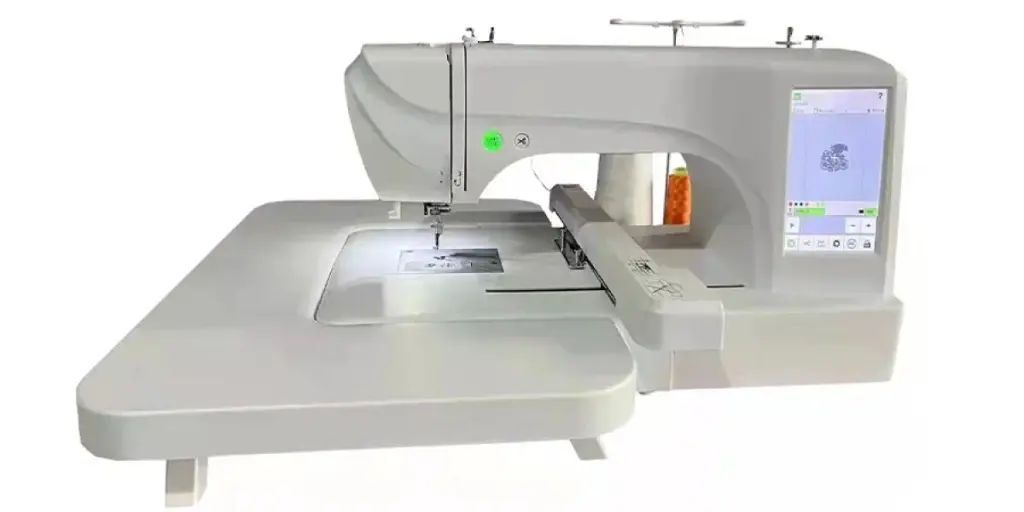Excellent embroidery normally requires excellent embroidery machines. In this guide, we’ll look at the types of embroidery machines available, what they feature, and their advantages and disadvantages. We’ll also look at the key aspects to consider before making a purchase for your business.
Table of contents:
Demand and market share for embroidery machines
Factors to consider when selecting embroidery machines
Types of embroidery machines available
Individual target markets for embroidery machines
Demand and market share for embroidery machines
The embroidery machine market share was pegged at $5687.6 million in 2020, and experts forecast a good growth potential in the coming years. Overall, fashion sewing and embroidery machines account for more than 60% of the market. Regarding dominant manufacturers of embroidery machines, the Asia Pacific region takes the lead with key players such as Xinsheng sewing, Le Jia, and Zoje Dayu.
Factors to consider when selecting embroidery machines
Not every embroidery machine is suitable for any business. While some users need high-speed machines for bulky work, others require machines that will help them kickstart a business. Here are the factors to consider when buying an embroidery machine.
Cost
The high cost of embroidery machines is a factor that demands consideration. The cost of a machine is normally proportional to the functions it offers. Some may cost as low as $800 while more advanced machines can cost $3800.
Hoop sizes
Every embroidery machine does not come with all the hoop sizes. It’s important to confirm the hoop sizes that an embroidery machine comes with in comparison to the hoop sizes required for the task. The smallest hoop size is 100 x 100. Some are as big as 360 x 350. In addition to this, it is recommended to know the number of additional hoop sizes.
Throat width
This is the distance between the needle and the machine. A large throat width allows for larger hoop sizes, more space to move around, and also allows for quilting, features that a smaller throat width wouldn’t provide. Medium arm machines have a throat width between 12”-17” while long arm machines have a width of 18”. Short arm machines will have a throat width of 7”-9”.
Connectivity
Some embroidery machines come with in-built designs while others don’t. In addition to this, some offer the ability to be connected to a computer or the internet in order to download designs that can be used by businesses. It is important to look at the available connectivity options a machine offers.
Accessories
It is helpful for businesses that are growing to consider the additionals that the embroidery machine offers. This includes a quilting table and different presser fits.
Design software
The design software of an embroidery machine enhances the designs that the machine can provide or develop. Basic machines may be unable to handle complex designs while more dedicated embroidery machines can manage design software that provides better capabilities.
Types of embroidery machines available
Here we’ll discuss the different types of embroidery machines available, what they feature, and their pros and cons.
Single needle embroidery machines
Single needle embroidery machines are the most basic of all embroidery machines.

Features:
- They have one head with an embroidery needle.
- They have the bobbin, the thread, and other essential elements on one machine.
Pros:
- They’re simple to use.
- They’re cost-efficient, and easy to purchase and maintain.
Cons:
- They have a shorter life span.
- They’re not suitable for bulky work.
- The largest hoop size most of them have is 5”x7”.
Sewing machines with an embroidery module
Sewing machines with an embroidery module are both a sewing machine and an embroidery machine because they have both technologies.

Features:
- They have built-in stitches in the embroidery module.
- They have a detachable wide table.
- 10 presser feet.
Pros:
- They can do both sewing and embroidery.
- They’re very fast at stitching (710 stitches per minute).
Cons:
- They can be quite costly to acquire and maintain.
- They have high power consumption.
Multi-needle semi-professional embroidery machines
Multi-needle semi-professional embroidery machines have several heads. They can develop several designs at a go.

Features:
- They have several attaching points from where to attach hoops.
- They’re single purpose and have all essential elements in one machine.
Pros:
- Less rethreading
- Easier hooping
- Good stitches
Cons:
- They’re expensive to acquire.
- Few people know how to operate and maintain them.
Multi-needle professional embroidery machines
Multi-needle professional embroidery machines can have up to 15 needles. They are the most advanced embroidery machines.

Features:
- They come with accessories such as backlit LCD screens.
- They’re multi-purpose machines and have several needles.
Pros:
- They provide better looking stitches.
- They’re very fast with speeds of up to 1200 spm.
Cons:
- They’re very costly.
- They’re not easily portable.
Individual target markets for embroidery machines
With a CAGR of 5%, the embroidery machine market is set to see a huge increase between 2021-2031 of over $2.4 billion. Factors contributing to this include the increased efficiency they provide, the limitation on human error, and the increased demand in the textile industry.
The Asia Pacific region was the global leader in 2020. Due to its increase in population and the growth of its textile industry, the region is expected to grow further followed by North America and Europe.
Conclusion
Embroidery machines have been able to make themselves relevant by embracing technology. We’ve looked at the different types of embroidery machines available. In addition to this, we’ve also seen some of the factors to consider before buying one that better meets the needs of each business. Head to the embroidery machines section on Alibaba.com for numerous listings of machines from global suppliers.




